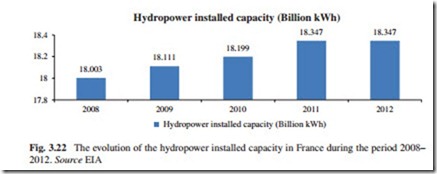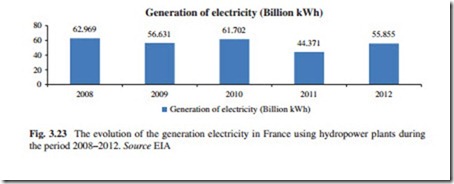France
The use of hydropower plants for the generation of electricity in France started at the end of the nineteenth century. Hydropower generating facilities in France con- sist of 640 dams and 435 hydropower plants. The average age of the installations is approximately 68 years. Hydropower plants are extremely diverse, and their out- put ranging from a few dozen kW to 1,800 MW, equivalent of an average-sized nuclear power plant. The oldest hydropower plant has now been in existence for more than 100 years.
An important hydropower construction program was planned just before the Second World War. However, the most active construction period began after the end of the Second World War, and was benefited from technological advances and from the nationalization of the electricity sector in 1946. The nationalization of electrical energy gave EN the monopoly for the production and transportation of electrical energy. Also, the electricity generated by independent producers (the private sector) must be bought by EdF at a rate close to its sales tariff, provided that it is produced in conformance with current laws.
The various hydropower plants operating in France are characterized by great diversity. Run-of-the-river hydropower plants account for 52 %, hydropower plants associated with lakes or reservoirs account for 27 %, and the rest is produced by other types of hydropower plants. There are several pumped-storage hydropower plants, including the Grandmaison site, which has the same power as two nuclear power plants.
In France, a law dating from 1919 gives the government the right to issue con- cessions for all hydroelectric production of more than 4.5 MW of installed capacity. Installations of smaller capacity are authorized at the regional level, either a department or a region. It is important to highlight that the French government makes no distinction between the various types of hydropower plants from the regulatory or fiscal incentive perspective. It does, however, facilitate access to EU loans for small-scale hydropower plants.
As happens in other European countries, the number of favorable sites which have not yet been developed is very limited. This scarcity of economically feasible sites means that total hydropower installed capacity has changed little dur- ing the past decade. The last major project was the commissioning in 1986 of the pumped-storage facility at Grandmaison of 1,800 MW. The variations in installed capacity are due to some new equipment (Le Buech, Puylaurent), but above all to the oversizing or the improvements of performance (increase in installed capacity). Consequently, the average energy production has remained stable at 69 TWh. The coming years should see a marginal increase in capacity, due to the installation of some run-of-the-river hydropower plants by independent producers.
According to Dambrine (2007), the country has a technical and economic remaining hydropower potential of 28 TWh per year that can be exploited during the coming years.20 This potential can be divided in 23.4 TWh for large-scale hydropower plants (between 10 and 50 MW), 3.5 TWh for small-scale hydro- power plants (between 100 kW and 10 MW), and 1 TWh for micro-scale hydro- power plants (between 10 and 100 kW). In addition, 500 new hydropower projects with around 24,000 MW are theoretically possible to be added during the coming years. These projects are divided in 18,200 MW for large hydropower plants, 4,300 MW for pumped-storage hydropower plants, 750 MW for small hydropower plants, and 600 MW for micro-hydropower plants.
With the aim of supporting the use of hydropower for the generation of electric- ity in France after 2012, the following measures should be considered:
• To carry out an inventory of the hydropower potential in the country taking into consideration local context;
• To undertake a study on the contribution of the pumped-storage hydropower
plants to the equilibrium of the network;
• To evaluate the relevance of a coordinated management of the concessions;
• To re-affirm the political goodwill of a revival of the hydropower sector and to facilitate the authorization of the construction of new hydropower plants;
• To encourage the technological innovations in the hydropower sector;
• To continue the use of mechanisms of financial assistance to the hydropower plants of less than 12 MW (Dambrine 2007).
3.15.1 Hydropower Installed Capacity
In 2012, the hydropower installed capacity in France, according to EIA sources, reached 18,347 MW, which represents 13.7 % of the total installed capacity in the country in that year. With respect to the total renewables installed capacity in
France in 2012, hydropower installed capacity represents 57.94 %. France occupies the place number 9 at world level with respect to the hydropower installed capacity, behind Japan and ahead of Sweden. Within the EU, France occupies the place number 2, behind Norway. During the past ten years, France reported an average growth in the hydropower sector of 0.14 %. This growth was registered in seven out of the ten-year period.
The evolution of the capacity of hydropower plants installed in France during the period 2008–2012 is shown in Fig. 3.22.
According to Fig. 3.22, the hydropower installed capacity in France during the period 2008–2012 increased 1.9 %. It is expected that new hydropower capacity will be installed in the country during the coming years, allowing that this type of energy source to be an important part of the energy mix of the country.
Hydropower Electricity Generation
The evolution of the generation of electricity in France using hydropower plants during the period 2008–2012 is shown in Fig. 3.23. According to that figure, the generation of electricity in France during the period 2008–2012 decreased 11.3 %.
It is expected that the generation of electricity using hydropower plants in the country will increase during the coming years, particularly if the government implement the decision already taken to reduce to 50 % the current participation of nuclear power in the energy mix of the country in the future.
According to the World Bank database, the generation of electricity in France using hydropower plants during the period 2009–2012 represented 10.2 % of the total electricity generated in the country in that period. It is expected that this percentage will be higher during the coming years.

